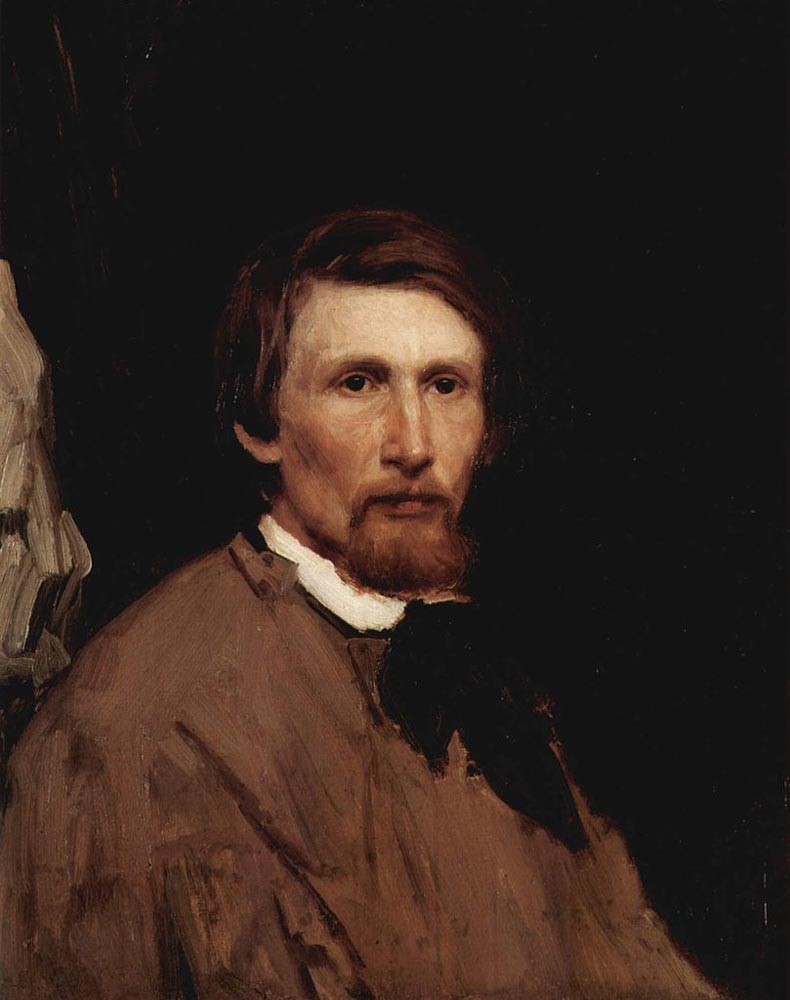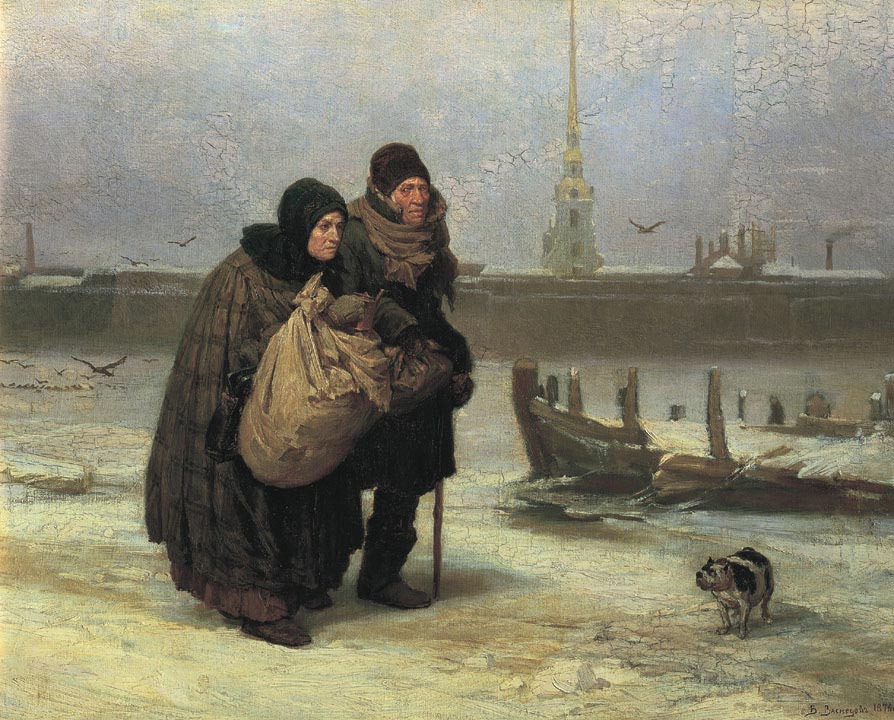| Viktor Vasnetsov | |
|---|---|
 |
|
| Born | May 15, 1848 Vyatka |
| Died | July 23, 1926 (at age 78) Moscow |
| Nationality | Russian |
| Education | Imperial Academy of Arts |
| Movement | Symbolism History painting |
| Field | Painting |
| Works | View Complete Works |
Viktor Mikhaylovich Vasnetsov (1848-1926), a Russian artist, was a major Russian Revivalist figure in the art world, and a co-founder of romantic modernism and folklorist art. Although a realist in the first years of painting, Vasnetsov later was intrigued by historical and mythological subjects, reforming the historical genre of the time, to a more decorative style in his later years of painting and designing. He was central in moving realism towards a more nationalist, and historical style, believing that a true work of art conveys the past, present, and maybe even the future.
Background in Art
Born in a small village of Vyatka Guberniya, Viktor was the second of six children. Viktor’s father Mikhail, was a village priest, who was also a painter, was interested in astronomy, and natural science. Taking after his father’s painting background, Viktor began painting local landscapes, and the people of his village. At ten years of age, Viktor went to a seminary to study within Vyatka, was employed at a local religious art shop, helped to paint frescoes for the local cathedral, and painted whenever he had a spare moment.
In 1867, Vasnetsov was admitted to the then named Imperial Academy of Arts, which was virtually a requirement of artists who were pursuing successful careers in art at that time. During this time of study, in 1870, fourteen students making up what was called the Peredvizhniki of painters who were rebelling against the Academy, finding Academy rules constraining, and the teachers too conservative. In an effort to bring art to the Russian people, the Association of Traveling Art Exhibits was established. Viktor befriended their leader, while also producing many recognized works of art, which were welcomed by some Russian societal circles.
 In 1876, Viktor joined the movement of the Peredvizhniki’s in Paris. While living in France, his studies focused on classical and contemporary paintings as well as academist and Impressionist styles. He placed several works on exhibit at the Salon, and also became fascinated with subjects centering on fairy-tales. Returning to Moscow in 1877, he began illustrating Russian fairy-tales and bylinas, or oral, epic, narrative poems.
In 1876, Viktor joined the movement of the Peredvizhniki’s in Paris. While living in France, his studies focused on classical and contemporary paintings as well as academist and Impressionist styles. He placed several works on exhibit at the Salon, and also became fascinated with subjects centering on fairy-tales. Returning to Moscow in 1877, he began illustrating Russian fairy-tales and bylinas, or oral, epic, narrative poems.
In 1874 and for the following fifteen years, Viktor was paid to paint frescoes in Kiev’s St. Vladimir’s Church. His challenging work was thought contrary to both traditional Russian and Western religious values. Critics were labeling them as sacrilegious, yet others viewed his works as a bridge between a two-hundred year separation of Russian societal classes. During this time period, Vasnetsov also designed sets and costumes for The Snow Maiden, Nikolai Rimsky-Korsakov’s opera in Italy.
The next two decades proved to be very productive years for Viktor, but many of his later works of art were not received well by the public. In these twenty years, he used his expertise in other media including theatrical design, and Russian Revivalist architecture, designing a mansion of his own in Moscow in 1894, and Tretyakov Gallery in 1904. He also designed a pavilion for the Russians during the World’s Fair of Paris in 1898.
 From 1906-1911, he designed mosaics for a Warsaw Cathedral and helped to design and build the Cathedral. His designs were coined fairy-tale buildings, yet Vasnetsov was incorporating Russia’s ancient past with archaeological accuracy, adding an atmosphere of mythical legend. In 1912, Viktor received a title of nobility from Czar Nicholas II. Viktor designed a postage stamp in 1914, in order to collect monies, which were donated to the victims during World War I. He also designed a uniform for the military Red Army in 1918, also creating the budenovka, or military hat.
From 1906-1911, he designed mosaics for a Warsaw Cathedral and helped to design and build the Cathedral. His designs were coined fairy-tale buildings, yet Vasnetsov was incorporating Russia’s ancient past with archaeological accuracy, adding an atmosphere of mythical legend. In 1912, Viktor received a title of nobility from Czar Nicholas II. Viktor designed a postage stamp in 1914, in order to collect monies, which were donated to the victims during World War I. He also designed a uniform for the military Red Army in 1918, also creating the budenovka, or military hat.
Periods of Evolution
Vasnetsov showed two distinct periods of evolution in his art. The realistic style of painting local people and landscapes gradually evolved into the nationalist and historical style of design, and architecture, drawing on Russia’s ancient history, adding his fascination of folklore, and romantic modernism. It seems a bit ironic, but Vasnetsov initially avoided historical and mythological subjects. In the early 1870’s, he produced many engravings which depicted contemporary Russian life. Boy With A Bottle of Vodka, in 1872, and Provincial Bookseller in 1870, won Viktor medals at the London World Fair, in 1874.
The 1870’s also produced Vanetsov’s genre oil paintings such as Peasant Singers in 1873, and Moving House in 1876. Acrobats was painted while Viktor was living in France in 1877. It reflects his study of the Impressionist style. At this time, his fascination with mythical subjects became prominent, and he began working on the painting Ivan Tsarevich Riding A Grey Wolf, and The Firebird. After returning to Moscow in 1877, some of his most well-known works of art were produced, such as The Magic Carpet (1880), Alionushka (1881), the Knight At The Crossroads, and Prince Igor’s Battlefield, in 1878.
Admired in the Future
Many of Viktor Vasnetsov’s art received very little appreciation during his lifetime. Critics dismissed his latter art as trying to undermine the realist principle of the time period. Little did they know that future generations would admire, respect, and adore Vasnetsov’s neorussian style, and how he was able to depict Russian history in a mythical, somewhat enchanting way.
In 1978, a small planet called 3586 Vasnetsov was named after Viktor, and his brother Apollinary, who was also an artist. Viktor’s creative works can be viewed at The State Tretyakov Gallery in Lavrushinsky Lane. The museum, which is the house that Viktor designed, allows viewers to really appreciate the diversity, and the value of Viktor Mikhaylovich Vasnetsov’s art.